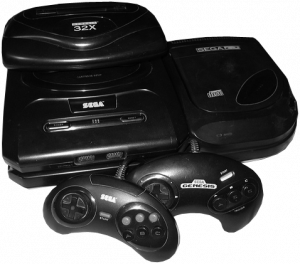Sega
 The Sega was the major competitor to Nintendo during the famous console war of the 90’s. Unlike its competitor, the Sega had a dangerous black finish that looked like it belonged to Batman and offered the unique feature of expandability. To call the machine in the picture here simply a “Sega” is a misnomer. The basic Sega Genesis (aka Mega Drive) is only the centralized console and control. Attached to it’s top port is the Sega 32x interface which added two additional coprocessors and the Sega CD attachment. Altogether, this device could be best understood as the “Sega System”.
The Sega was the major competitor to Nintendo during the famous console war of the 90’s. Unlike its competitor, the Sega had a dangerous black finish that looked like it belonged to Batman and offered the unique feature of expandability. To call the machine in the picture here simply a “Sega” is a misnomer. The basic Sega Genesis (aka Mega Drive) is only the centralized console and control. Attached to it’s top port is the Sega 32x interface which added two additional coprocessors and the Sega CD attachment. Altogether, this device could be best understood as the “Sega System”.
At the time of the Sega Genesis release, NES was the number one game system in the USA and featured an unprecedented library of video games and vitrually zero competition. Despite its popularity, the NES was limited to its 8-bit architecture, limiting its capacity for better graphics and sound. Into this void, the Sega Genesis launched an agressive marketing campaign using the phrase “Sega does what Nintendon’t”. Furthermore, Sega did not restrict gore and adult themes as strongly as Nintendo. The Sega rose to power and kept a strong competition with Nintendo even into the release of the SNES system. In fact, the 32X module and the SegaCD allowed it to hold its ground up to the release of the Nintendo64. Sega’s parent company eventually shutdown the production of the Sega Genesis due to mechanical limitations and limited game portability. It put most of its hope on the Sega Saturn after essentially passing up the opportunity to own the consoles that became the Nintendo64 and the Sony Playstation.
| Sega Genesis | |
|---|---|
| US Release: | Aug. 14, 1989 |
| Processor: | Motorola 68000 16/32 bit processor: 7.67Mhz |
| Co-Processor (Sound): | Zilog Z80, 8-bit 3.58MHz |
| Memory: | 64K Onboard RAM |
| Video: | 512 colors at 3:3:3 ratio. |
| Sound: | Yamaha YM2612 5 channel audio with 4 channel PSG (Programmable Sound Generator) |
| Sega CD | |
|---|---|
| US Release: | Oct. 15, 1992 |
| Processor: | Motorolla 68000 16-bit CPU, 12.5 MHz (could be used as coprocessor with 32X/Genesis) |
| Memory: | 4MB Program RAM, 2MB Word RAM, 64k internal backup |
| Video: | Custom ASIC 64 individual colors onscreen, Cinepak movie codec |
| Audio: | 16 Bit Pulse Width Modulation interface with 8 extra audio channels |
| Sega 32X | |
|---|---|
| US Release: | Nov. 1994 |
| Processor: | Dual SH2 32-bit RISC Processors at 23.01 MHz |
| Memory: | 256 MB Program RAM and 128 MB Framebuffer |
| Video: | 32,768 colors on screen with backwards compatability to Genesis games |
| Audio: | 10 Bit Pulse Width Modulation interface with 12 audio channels |
| Sega Saturn | |
|---|---|
| US Release: | May 11, 1995 |
| Processors: | 2 x Hitachi RISC SH-2 CPU, 28.6 MHz, Motorola 68EC000, 11.3 MHz |
| Memory: | 16MB RAM, 4MB Sound RAM, 4MB CD Buffer RAM, 256KB internal backup |
| Video: | 16.77 Million colors using VDP1 for textures and polygons, VDP2 for background processing |
| Audio: | 32 bit Saturn Custom Sound Processor (SCSP). |
